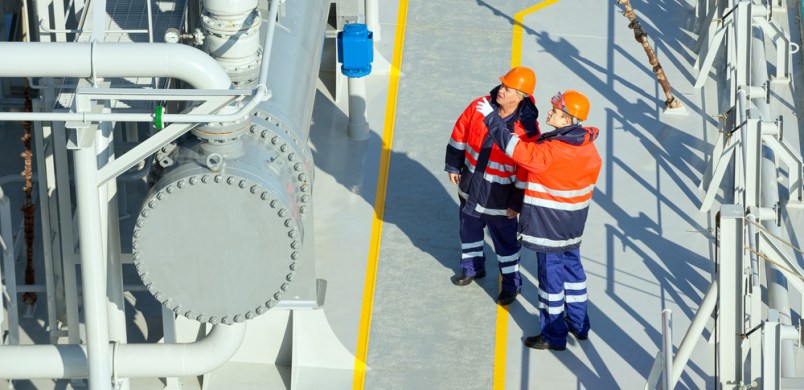Methane, a greenhouse gas (GHG), has been top-of-mind for many of the nation’s environmental regulators over the past year. Though emissions of this particular GHG from the natural gas and oil sector represent a little less than three percent of total U.S. emissions – followed closely by the U.S. cattle industry—the Obama administration has proposed new restrictions on energy producers, targeting a 40 to 45 percent reduction in methane emissions over the next decade.
As the natural gas industry voluntarily works to control these emissions, here are five key dynamics to watch in the ongoing conversation over the methane rule.
Emissions are falling even as production climbs to record highs.

Methane reductions are taking place during an historic period for the natural gas industry.
The shale gas revolution of the past decade has upended the global energy paradigm, with the U.S. now expected to be a net natural gas exporter by next year. Production has climbed 35 percent from 2005 levels, and this long-term trend is supported by the U.S. Department of Energy, which anticipates production to soar by 56 percent by 2040.
When viewed against this backdrop, the industry’s voluntary efforts at reducing methane emissions are impressive. Since 2005, natural gas producers have slashed methane emissions by 38 percent in a proactive and collaborative approach with regulators, environmental groups and technology developers to implement innovative new solutions.
Voluntary methane reduction programs are working.

The surest way to forge ahead in business is to fire up a little friendly competition. Which is why natural gas producer’s Apache, Anadarko and others have joined the Environmental Defense Fund’s “Methane Detectors Challenge.” The goal of the program is to spur development and use of real-time technologies that monitor emissions and improve the process for finding and fixing methane leaks. Independent experts from the Environmental Protection Agency (EPA) and the Houston Advanced Research Center are overseeing submissions that if chosen, will be purchased and deployed on a trial basis later this year.
The Methane Detectors Challenge is just one of many voluntary initiatives taking place across the energy production community. Producers are also working with EPA to deploy green completion technologies that capture natural gas at its source, a technique that can nearly eliminate methane emissions at the wellhead.
What’s more, methane is itself a highly valuable fuel source; capturing these emissions helps improve the bottom line.
As industry leaders continue to set a high bar for methane reductions, their actions are having an impact. EPA itself has pointed to the strides producers have made to cut methane, saying “voluntary efforts to reduce emissions in a comprehensive and transparent manner hold the potential to realize significant reductions in a quick, flexible, cost-effective way.”
Methane is a small slice of a big GHG pie.

When identifying the country’s biggest emissions culprits, context is critical. At 82 percent, carbon dioxide represents the vast majority of GHG emissions, while methane is approximately 10 percent of the total. As operations become increasingly efficient, methane emissions from the natural gas sector now represent less than three percent of all GHG emissions in the U.S.
Power generation, agriculture, industrial manufacturing and transportation are all major emitters. Beyond GHGs, controlling pollutants like sulfur dioxide and smog-forming nitrogen oxide is also essential for the overall well-being of our atmosphere and citizens.
CO2 emissions are at a 30-year low thanks to natural gas.

The U.S. has reduced carbon emissions more than anyone else over the past eight years. These reductions are primarily due to the increased use of natural gas for power generation.
In April of this year, for the first time ever, the country used more natural gas than coal to produce electricity. That same month, carbon emissions hit their lowest level in nearly 30 years.
The bottom line is that natural gas produces half as much carbon dioxide when used for power generation compared with other fossil fuels, and burning it for electricity has reduced emissions of other smog-forming pollutants like sulfur dioxide and nitrogen oxide 44 percent and 40 percent respectively since 1997.
With low, stable prices and growing resource estimates, utilities are using more and more natural gas, building new combined cycle power plants and retiring or retrofitting older facilities that won’t fall into compliance with new federal power plant regulations.
Natural gas is critical to our clean energy future.

Our air is cleaner today than it has been in decades, thanks in large part to utilities using more of this cleaner fuel to produce electricity and producers aggressively seeking out methane leaks and eliminating the threat to both air quality and their bottom line.
Beyond methane, the growing role and future success of renewable energy depends on the clean and quick-firing capabilities of natural gas as a back-up generation source, powering up when the sun sets or the wind dies down.
President Obama, the EPA and environmental groups like EDF all agree that natural gas is crucial in meeting the demand for reliable clean energy.
But as the EPA proposes complex regulations for methane, natural gas users and producers face uncertainty that could undermine progress towards cleaner energy and a stronger economy. Natural gas producers have the incentive to cut emissions and a proven track record of success in improving methane reductions over the long haul, without costly and duplicative federal regulations.







Could we see some source citations for this article? I’d hate to think that this is simply a Natural Gas ad buy on TPM masquerading as a news story.
Was wondering the same thing. Only indication on mobile site is that the byline is “ANGA” which I assume is America’s Natural Gas Alliance and not a new cub reporter.
Please be much clearer about labeling ads.